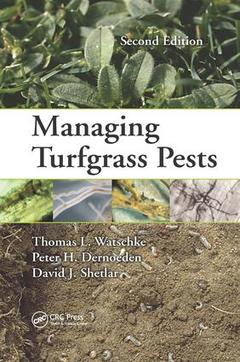Description
Managing Turfgrass Pests (2nd Ed.)
Authors: Watschke Thomas L., Dernoeden Peter H., Shetlar David J.
Language: English
Subject for Managing Turfgrass Pests:
Keywords
Tall Fescues; Annual Bluegrass; annual; Kentucky Bluegrass; bluegrass; Cool Season Grasses; tall; Chinch Bug; fescue; Mole Crickets; cool; Sod Webworms; season; Pythium Blight; grasses; Gray Leaf Spot; smooth; Summer Patch; crabgrass; Golf Greens; turfgrasses; Mowing Height; White Grubs; Perennial Ryegrass; Fairy Ring; Warm Season Grasses; Class Insecta; Damage Symptoms; Leaf Spot; Seashore Paspalum; Parasitic Nematodes; Nitrogen Fertility; SDS; Smooth Crabgrass; Contact Fungicides
89.57 €
In Print (Delivery period: 14 days).
Add to cartPublication date: 11-2017
· 15.6x23.4 cm · Paperback
256.94 €
In Print (Delivery period: 15 days).
Add to cartPublication date: 06-2013
· 15.6x23.4 cm · Hardback
Description
/li>Contents
/li>Readership
/li>Biography
/li>
Written by three of the top professionals in the turfgrass field, Managing Turfgrass Pests, Second Edition brings together hundreds of solutions and best practices to help you manage turfgrass weeds, diseases, and insects more effectively. Since the publication of the bestselling first edition, advances in pest-resistant turfgrass cultivars and pest control products have led to significant changes in the ways pests are managed. This revised and updated second edition reinforces those management tactics that are still relevant and covers new approaches that have been introduced since the first edition.
The book discusses the concept of integrated pest management, incorporating cultural, biological, and chemical control measures. In particular, the authors emphasize the philosophy of minimizing pests through well-defined and well-implemented cultural systems. Rather than simply relying on a pesticide solution for control, they explain how to fine-tune cultural practices to better address the question of why the pest is present in the first place. Once these cultural practices are in place, any pesticide that is still required will be much more effective at controlling the pest.
New in This Edition
- Revised and updated descriptions of economically important turfgrass pests
- Revised and updated cultural approaches to turfgrass pest management
- Revised and updated biological methods of turfgrass pest management
- Revised and updated chemical control of turfgrass pests
- More than 200 new color illustrations
Packed with photographs, this full-color book provides updated information on best practices and control measures for turfgrass pest management. It also explains how to integrate various management strategies to ensure quality and functional turf. Throughout, the authors offer practical recommendations to help you optimize the competitiveness of your turfgrass against the pests that inevitably become part of any ecosystem.
Weeds and Their Management: Introduction. Managing Turfgrass Weeds. Managing Summer Annual Grasses. Managing Winter Annual Grasses. Managing Perennial Grasses and Sedges. Managing Summer Annual Broadleaf Weeds. Managing Winter Annual Broadleaf Weeds. Managing Biennials. Managing Perennial Broadleaf Weeds. Weed Management: Integrated Pest Management. Chemical Control Recommendations. Further Reading. Turfgrass Diseases and Their Management: Introduction. Monitoring Disease and Establishing Thresholds. Environmental Conditions and Use of Cultural Practices to Manage Diseases. Biological Control of Turfgrass Diseases. Winter and Early Spring Diseases. Diseases Initiated in Autumn or Spring That May Persist Into Summer. Diseases Initiated During Summer That May Persist Into Autumn. Seedling Diseases or Damping-Off. Bacterial Diseases. Plant Parasitic Nematodes. Virus Diseases. Blue-Green Algae, Moss, and Black-Layer. Collecting and Sending Diseased Samples to a Lab. Fungicides Used to Control Turfgrass Diseases. Acknowledgments. Bibliography. Turfgrass Insect and Mite Management: Goal of Insect and Mite Management. Pest Management Process. Pest Identification. Insects and Mites Associated with Turf: An Introduction. Pest Life Cycles. Zones of Activity (Turf, a Unique Habitat). Monitoring. Selecting Appropriate Controls. Leaf- and Stem-Infesting Insect and Mite Pests. Stem- and Thatch-Infesting Insect and Mite Pests. Soil-Inhabiting (e.g., Thatch- and Root-Infesting) Insects. Nuisance Invertebrate, Insect, and Mite Pests. Nuisance Vertebrate Pests. Further Reading. Index.
Dr. Thomas L. Watschke is presently professor emeritus of turfgrass science at the Pennsylvania State University, where he was on the faculty for 35 years. Dr. Watschke has been honored nationally by the Golf Course Superintendents Association of America and the American Sod Producers Association, Division C-5 (ASA, CSSA) Grau Award, and has been accorded fellow status by both the Crop Science Society of America and the American Society of Agronomy. He is recognized throughout the world for his teaching and research accomplishments in weed science, plant growth regulation, and water quality. He has made presentations in France, Australia, Spain, England, Scotland, and Canada and is active in the International Turfgrass Society.
Dr. Peter H. Dernoeden is a professor of turfgrass science in the Department of Plant Science and Landscape Architecture at the University of Maryland. Dr. Dernoeden has published more than 100 scientific journal articles and several books, including Creeping Bentgrass Management, Second Edition. He is a Fellow of the American Society of Agronomy and the Crop Science Society of America (CSSA). He received the Fred V. Grau Turfgrass Science Award from the Turfgrass Science Division of CSSA. He was also the recipient of The Dean Gordon Cairns Award for Distinguished Creative Work in Agriculture from the College of Agriculture and Natural Resources at the University of Maryland. In 2012, he received the Colonel John Morley Distinguished Service Award from the Golf Course Superintendents Association of America.
Dr. David J. Shetlar is a professor of urban landscape entomology at The Ohio State University. Dr. Shetlar has authored and coauthored numerous trade magazine articles, research journal articles, books and book chapters, and extension factsheets and bulletins. Dr. Shetlar, who goes by the professiona




